Car-of-the-Year finalists battle to the end
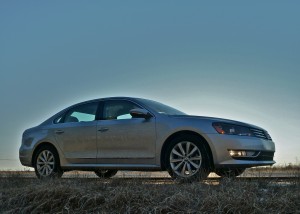
Made-in-U.S. Volkswagen Passat joins Ford Focus and Hyundai Elantra as 2012 Car-of-the-Year finalists.
By John Gilbert
The most competitive battle for North American Car of the Year and Truck of the Year has boiled down to three finalists in both categories, and with time running out before the early January voting deadline, the choices are difficult.
In my 19 years on the jury, there hasn’t been another year where the field has been as balanced and diverse as this one. Unlike car magazines, which attract multi-page advertising sections, and revenue, to accompany their “car of the year†selections, the 50 independent automotive media jurors from all over North America consider our award the purest. No outside advertising or influences intrude, and we pay dues that go toward creating our very impressive sculptured award, which is presented on the first press day of the Detroit International Auto Show in January.
Candidates must be all new or significantly revised to be considered new, and the first round of votes eliminated some very strong candidates. We now have one more round of voting, after a couple of weeks, spent scurrying to get one more test-driving taste of most, if not all, of the finalists.
Car of the Year finalists, alphabetically, are:Â Ford Focus, Hyundai Elantra, and Volkswagen Passat. Truck of the Year finalists are:Â BMW X3, Honda CR-V, and Range Rover Evoque. Strong candidates, all., and they left some impressive others behind in preliminary voting. In the cars, the three finalists span North America, Europe, and Asia, with the U.S., Germany, and Korea represented in the truck battle, with two European designs and one from Japan.
When the votes were tallied, the Elantra outpointed the runner-up Passat and the Focus to win the car award, and the Evoque gave Land Rover its first victory by claiming truck honors ahead of the runner-up CR-V and the BMW X3. But here is a capsule view of all three finalists in both categories. Read more
When does a touchdown earn 2 points?
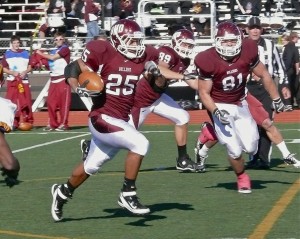
Zach Hulce, a transfer and senior, got his chance in the UMD backfield and promptly ran for two touchdowns against Northern State.
By John Gilbert
Watch sports live or on television, and no matter how many games you see, you’re likely to see something you’ve never seen before. Take the UMD football game against Northern State University last Saturday. There were no arguments, but there was one play that could be put in a time capsule to show how difficult the officials’ job can be, and raise some stimulating questions, at the same time.
When is a touchdown worth only two points? When is a safety actually a touchdown? When can a ball-carrier land on his backside on his 1-yard line, but be ruled in the end zone? When could one play be called any of three ways and a logical case could be made that any of the three was correct?
Only in a UMD football game, apparently. It happened at a crucial spot in last Saturday’s homecoming game, with the Bulldogs clinging to a 7-6 lead over Northern State of South Dakota. (Makes you wonder, by the way, if there’s a Southern State of North Dakota, doesn’t it?) Twice in the game, UMD’s hustling special teams attackers downed punts at the 1-yard line, putting the Wolves in serious trouble. On the second of these, in the second quarter, with UMD leading 7-6, the Bulldogs attacked on defense. On third and nine from the 3, Northern quarterback Nick Wanner tried to gain some running room, but was jolted at the line of scrimmage, and as he fell backwards the ball was fell loose for a fumble. As the ball landed in the end zone, UMD senior Derrick Zappa, who seemed to be in the middle of every Northern play all day, pounced on it. His teammates raised their arms, signaling “touchdown,†as one official, on the goal line, also signaled “touchdown.†Another official, however, signaled “safety,†and after a brief discussion, the ruling was for a safety, two points for the Bulldogs to increase a 7-6 lead to 9-6.
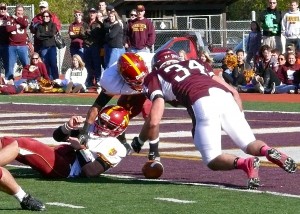
Northern State's Nate Wanner lost the ball before his tail-first landing just outside the end zone; the ball clearly was at rest over the goal line, as UMD's Derrick Zappa pounced to recover for an apparent touchdown.
As the accompanying photos indicate, Wanner’s rear end is down at about the 1, and his upper body is falling backwards, toward the goal line. The ball is already loose, on the turf in the end zone, as Zappa pounces on it. The case could be made for three possible rulings: (A.) Wanner was down where his butt hit the turf, before he lost possession, making it fourth down, Northern, on its 1; (B.) Wanner was going down, and his upper body wound up crossing the goal line before the fumble, so it was a safety; or (C.) Wanner fumbled as he was going down, so it didn’t matter where he or his butt landed, it was a loose ball, meaning touchdown UMD when Zappa recovered.
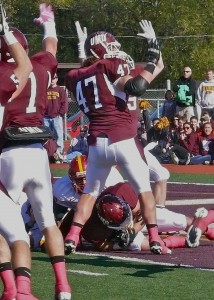
The Bulldogs celebrated a touchdown, but officials ruled it a safety, meaning Wanner was down, in the end zone, before he fumbled.
The officials chose “B†but it appeared evident to me (and my camera) that it had to be “C.â€Â I was walking the sideline, right near the goal line, and it was clear that the ball had come loose as Wanner was going down, and it landed on the ground as Wanner landed a few feet away. The ball had to still be in Wanner’s possession, with Wanner in the end zone, for it to be a safety, but clearly, no part of Wanner’s body crossed the goal line when he still had possession, so it couldn’t be a safety. The only plausible call was that it was a fumble, and a touchdown for Zappa and the Bulldogs. This is not so much a second-guess, as to relate the rarity of having three potential rulings on one play, and nobody on either side would have argued no matter which one they chose.
Fortunately, the Bulldogs went on to win 37-6 with a strong second half, and now stand 7-1 overall and 6-1 for a share of first place in the Northern Sun. The eventual title could well be determined Saturday, when the Bulldogs play at St. Cloud State. A huge factor for UMD was that freshman running back Austin Sikorski, who had broken loose for 185 yards the previous weekend, and gained 23 yards on five carries through the first quarter, mostly on UMD’s first touchdown drive, went out with a knee injury and was helped off the field.
Second-unit running back Brian Lucas, who often alternated with fellow-freshman Sikorski, finished off the first-quarter drive with a short touchdown run, and carried 16 times for an even 100 yards in the game. Coach Bob Nielsen had an interesting philosophy. “With Sikorski out, I tried to limit Lucas’s reps,†Nielsen said. So he went to third-unit transfer Zach Hulce.
Hulce, from outstate Washington, attended Glendale Community College in Arizona, then transferred to West Virginia, before being sidelined with a knee injury. He transferred to UMD, and has been waiting his chance as a senior. It appears he made a good choice. “I’m not really into the cold, but I like to win,†he said. Hulce carried 8 times for 85 yards, breaking free for two successive second-half touchdowns that turned a 16-6 lead to a 30-6 bulge. Hulce ran through an enormous hole for a 20-yard touchdown run in the third quarter, and blasted through several defenders before sprinting 44 yards for a fourth-quarter touchdown. Steve Ierilli, the fourth running back of the day, added 68 more yards on nine carries, mostly in the fourth quarter.
WCHA WOMEN’S RACE TIGHT
The UMD women’s hockey team played two strong games last weekend, but lost a wrenching 4-3 first game to Wisconsin at Amsoil Arena. The Bulldogs had a weird second game, heavily outshooting the Badgers, but lost 6-3 after a faltering first period. The Badgers have a lot of firepower returning from last year’s WCHA and NCAA champs, and deserve their No. 1 rating.
UMD can take inspiration from both losses, however. In the first game, after spotting Wisconsin a goal by Brianna Decker, freshman Jenna McParland scored twice to lift UMD to a 2-1 lead after one period. Her first goal came on a power play, when Haley Irwin squeezed a pass from deep on the right side through the crease — behind goalie Alex Rigsby — and McParland had a slam-dunk at the left post. Wisconsin turned up the attack in the second period, outshooting UMD 17-7, but had to wait until the closing minutes to get goals from Carolyne Prevost and Hilary Knight for a 3-2 lead at the second intermission. Audrey Cournoyer scored for UMD at 7:18 of the third, tying it 3-3, and the game seemed headed for overtime, until a Badger penalty gave UMD a late power play. But with 1:14 remaining, the irrepressible Knight broke free and scored on a shorthanded breakaway to give the Badgers a 4-3 triumph.
In the second game, UMD roared to the attack at the outset, outshooting the Badgers 12-3 for the first 14 minutes, but unable to get anything past goalie Alex Rigsby. When UMD got the only penalty of the first period, Hilary Knight (who else?) scored with a power-play slapshot at 17:05, then Brianna Decker scored at 18:04, and Kelly Jaminski scored at 18:39. The three Badger goals in a 1:34 span put the Badgers in command.
UMD fought back when Pernilla Winberg scored on Haley Irwin’s pass out, but Carolyne Prevost got her first of two goals and Saige Pacholok got another for a 5-1 Wisconsin lead.
Pacholok’s goal, at 18:16 of the middle period, was another one of those rarities. She was called for a delayed penalty for interference, and on the delay, goalie Jennifer Harss raced out of the UMD goal for a sixth attacker. UMD’s Vanessa Thibault had the puck deep in the right corner during the delayed-penalty advantage, and when she fed a pass back to the right point, it hopped the stick of Tea Villila at the point, and slid all the way down the ice — 175 feet or thereabouts, and right into the unguarded UMD net. Pacholok was sent to the penalty box for her delayed interference, and was later named as the official goal-scorer because she was last to touch the puck before UMD’s “own†goal-against.
UMD, which outshot the Badgers 23-7 in the second period, closed the deficit to 5-2 when Audrey Cournoyer scored on an Irwin rebound during a two-skater power play to end the middle session. And when Katie Wilson scored a power-play goal to open the third, it brought the Bulldogs up to 5-3. One more goal would have put them close enough for a pulled-goalie finish, but Prevost scored into the empty net with 24 seconds remaining to secure the 6-3 finish.
Wisconsin coach Mark Johnson said his Badgers might get an easy weekend, but he can’t envision it yet. “We started with North Dakota, then we split with Minnesota, then we come here to face the Bulldogs, and next weekend we play Boston University,†said Johnson. “North Dakota is definitely a top contender, and we beat Minnesota in a hard-fought game before they blitzed us in the second period. Same thing here against Duluth. It’s great for our league to have so many competitive teams, even if it gives us coaches grey hair.â€
Shannon Miller’s Bulldogs are at home again this weekend in an action-filled Amsoil Arena. The UMD men play Bemidji State Friday and Saturday nights, while the UMD women face North Dakota’s best team ever in 3 p.m. games Saturday and Sunday.
Not to be outdone, the undefeated UMD volleyball team, which snapped Concordia of St. Paul’s winning streak to take over first place in the Northern Sun, will put its unbeaten 14-0 league record on the line at Romano Gym against Northern State at 7 p.m. Friday, and the University of Mary on Saturday at 4 p.m., before a Tuesday night nonconference “breather†against Concordia of St. Paul — which will try to reverse things and snap UMD’s perfect season. UMD is 23-0 overall, while Concordia, which won the first and third games before UMD rallied to win the last two, is now 13-1 and 22-1 overall. While the rematch is nonconference, it could have far-reaching impact on upcoming playoff seedings.
Evoque drives Range Rover into future
By John Gilbert
What’s a sleek shape like you, doing with a name like Range Rover? That’s a fair question to ask of the 2012 Evoque, a departure that may prove the direction of Range Rover SUVs from now on.
Since 1948, Range Rover has solidly over-engineered SUVs before the nickname was invented, and all of them could conquer the most rugged off-road challenges. As years passed, they refined the Range Rover and Land Rover vehicles until they became the prestige cars of choice for customers who could afford to display their taste for unexcelled quality and versatility. Refinement never threatened Range Rover’s distinctive square shape at all four corners, however. Until now, that is.
A couple of years ago, the LRX, a Range Rover concept vehicle, Â hit auto shows with a startling new shape. Its chances to advance beyond concept stage seemed remote, but last year, the production Evoque became the newest auto show specimen, but it still seemed mostly fantasy. Suddenly, for 2012, the Range Rover Evoque has come to life and is on the road.
From the front, it bears a streamlined resemblance to the recognizable boxes of Range Rovers past. The rest of the body, however, leaves behind the boxy silhouette for a much sportier, sloped-back look. Its light and lean looks make sense, because it is the smallest and lightest Range Rover, with unique styling that stands out from all its siblings, and all other SUVs as well.
It performs as impressively as it looks, taking off with surprising swiftness. You can upshift through six gears by using steering wheel paddles, if you choose to manually override the 6-speed automatic transmission’s capabilities. It also cruises effortlessly at freeway speeds.
My test-drive Evoque was a 4-door in Indus Silver, wearing Prestige trim. The Evoque comes in an extra-sleek 2-door “coupe†design as well, which has an even sportier appearance, although the tapered roof of the test Evoque pretty effectively hides the fact it has four doors. Evoques come in Pure, Prestige, and Dynamic trim, with Pure being basic — but pretty fully loaded, while Prestige adds special 19-inch or available 20-inch wheels and tires and is filled with opulent creature comforts, and Dynamic is dressed for sporty use, with bolder interior schemes. Read more
Ducks had Rosey look from season’s start
(This article was originally written in mid-September, 2011, and after Oregon and Wisconsin won their way to the Rose Bowl, it appeared appropriate to reprint it here, in early December of 2011.)
By John Gilbert
Two weeks into the football season, and I may have just finished watching the Rose Bowl champion. You can bet on Wisconsin, if you’re a Big Ten loyalist, or you can bet on Nebraska, if you realize what the Big Ten has recently done. Or you could bet on Arizona State or someone exotic.
Me? I’m taking the Oregon Ducks.
A group of us, who write about automobiles, were gathered together in Portland, Oregon, where we had a good time driving the new Hyundai Veloster all day, and attending a venue or two of the Northwest Music Festival at night. Then came Saturday, and we drove Velosters — neat little sporty coupes that are quick, fun to drive, and should get over 40 miles per gallon, all for a price of under $15,000 — down to Eugene to watch Oregon play its home opener against Nevada.
Now that game might not have held such interest for me if we had a major college football attraction right here in Minnesota. But the University of Minnesota proved that its tradition is stronger than new coach Jerry Kill could have foreseen. The plan is to celebrate for a week losing close to a strong team, such as Southern California, and then fall flat on its face against a really poor team, such as New Mexico State. Losing that game, in the Gophers home opener, caused Kill to suffer a seizure on the sideline. Word is, he’ll get out of the hospital and be back on the bench for this Saturday’s game. Which makes you wonder if he’s a reasonable fellow, after all.
The Vikings, of course, went out to San Diego with their new quarterback, Donovan McNabb. I think McNabb might have a big year, but I worry that he might be over that proverbial hill. He completed five passes, for 39 yards, the worst statistics in his long, long, looooonnng, career. And the Vikings lost to the Chargers in their season-opener.
Fortunately for those of us in Duluth, we have Minnesota-Duluth, the defending Division II champion, and the No. 1 ranked D-II team in the land again. I missed the home opener, against Upper Iowa, which gave the Bulldogs a good battle. This weekend, it’s off to Bemidji State, and the fact is already established that even this early in the season, the best team, and the best-coached team, in Minnesota is the UMD Bulldogs.
Back to the Big Ten, which has been over-rated for about five or six years now. Sure, there’s Michigan, and Wisconsin, and occasionally Iowa or Penn State, but in general, the Big Ten is not in the class of the Southeast Conference, or the Pac-10, or whatever they’re calling the one that used to be the Big Eight, and the Southwest, before they tried to combine them, or break them up, or whatever.
Personally, Boise State is my new favorite D-1 team, simply because the NCAA’s Bowl championship playoff system is weird, and I always pull for Boise State to win enough games to foul it up. Last year, Boise State lost one game, and it was at Nevada, when Boise’s usually can’t-miss placekicker missed what would have been the game-winning field goal at the end of regulation, and incomprehensibly missed again to cost Boise the chance to win in overtime and go undefeated.
This season, Oregon started ranked No. 2 in the country, and played No 4 LSU down in New Orleans to open. LSU beat the Ducks, but not until Oregon had decisively outgained LSU but blew the game with fumbles and interceptions. That set the stage for last Saturday’s Oregon home opener, where the Ducks had won 16 straight games, and the opponent was Nevada, which promised to be a formidible foe, after a 13-victory season in 2010 and bringing a seven-game winning streak into this season.
Promises, however, aren’t always easy to keep. It was a hot day, in the 90s, very little breeze, during a record September hot spell that has turned some of the more fertile fields to dust. We trooped into Autzen Stadium and sat low in one corner. What unfolded below us was a pretty incredible performance.
An unusual pattern developed. Nevada had some extremely fast defensive secondary players, but their defensive scheme must have anticipated Oregon would only throw short passes. On several occasions, a Duck would race down the sideline, into the clear, and catch a pass from Darron Thomas with no defender within 20 yards of him. Yet in a couple of seconds, the speedy defensive secondary guy would overtake the Oregon receiver and nail him to prevent a touchdown. It made you wonder why, if they were fast enough to overtake the Oregon receivers, they didn’t simply back off on the tight coverage and prevent the easy receptions in the first place.
Oregon jumped ahead 13-0 in the first quarter, and in the second quarter one of the more misleading statistics in football history showed Nevada with the ball for 11:02, and Oregon with the ball for 3:58, but Oregon outscored Nevada 28-7 in the quarter. Oregon had the ball seven times in the first half, scored six touchdowns, and punted once, then the Ducks scored two more touchdowns on their first two possessions of the second half. When it was over, the Oregon Ducks had beaten the Nevada Wolfpack 69-20.
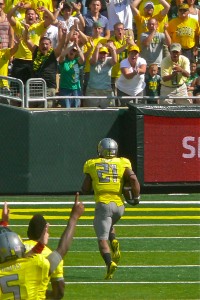
The most common view of Oregon's LaMichael James, whose Rose Bowl will have to be his Heisman Trophy.
Darron Thomas threw six touchdown passes, while going 13-19 for 295 yards. LaMichael James, who was among front-runners for the Heisman Trophy last year, scored on a 67-yard touchdown run, caught a pass from Thomas for another TD, and ran a punt back for his third touchdown of the day. De’Anthony Thomas caught two passes for the day, both for touchdowns.
Oregon completed 15 passes to Nevada’s 23, but Oregon averaged 22.1 yards per reception to Nevada’s 10.1 yards. And, Oregon intercepted three Nevada passes.
The capacity crowd was dressed in predominate yellow, and kept up a low yell of “OOOOOOOO-ooo-oooo-oh.†Apparently in Oregon, Ducks yell something that sounds like “Oh.†It was a fun crowd, jovial, and only occasionally abusive to the Nevada visitors. Battalions of Oregon cheerleaders pretty much encircled the playing field, but the Nevada cheerleaders did fine, too. On one occasion, the Nevada cheerleaders raced into the end zone, doing a series of flips and complete somersaults in the air, prompting the comment that the Nevada cheerleaders were more talented than the Nevada secondary.
There’s a long way to go in this season, of course, but when all the firing is done, and they’re picking the teams to play in the Rose Bowl, you can pick whichever team you like. I’m picking Oregon.
Go Ducks.
DJOKOVIC — REMEMBER THE NAME
During the French Open, I wrote here that some talk-show guys were making fun of the fact that Roger Federer and Rafael Nadal were meeting in the final, saying of course they were because they are the only two recognizable names in men’s tennis. I pointed out that when you don’t know something, you don’t need to go on radio to prove your shortcomings, because when Federer beat Novak Djokovic in the semifinals, it was the first time Djokovic (pronounced, “Joe-ka-vichâ€) had lost a match since November, and that he was easily as good, if not better, than Nadal or Federer right then.
Sure enough, when they played at Wimbledon, Federer won the first two sets, then Djokovic put on one of the great clinics in pro tennis history to win three straight to gain the final, where Djokovic, from Serbia, beat Nadal, from Spain.
In case you missed it, the U.S. Open finished the 2011 season of majors last Monday, and once again Djokovic, now ranked No. 1 in the world, had to face Federer in the semifinals. Again Federer won the first two sets. And again, incredibly, Djokovic won the third, fourth and fifth sets to claim the match. That made it only two times in his career that Federer had won the first two sets and lost the match, and they were in the last two majors, against Djokovic.
That sent Djokovic, No. 1, against No. 2 Nadal in the final, and it was a repeat of Wimbledon. Djokovic won the first two sets, lost the third, then won the fourth to claim his third of four majors this year. Once again, Nadal played well enough to beat Federer or anybody else on the tennis tour, but it wasn’t good enough to beat Djokovic. Djokovic’s record for the year is 34-2, which analyst John McEnroe said was probably the most incredible season any tennis player has ever had.
ROY WAS NEVER A STAR
The last time I saw Roy Niemi was in the Super One store on 60th Avenue East and Superior Street. Just a chance meeting, but, as usual, we stood and talked for long minutes, and then we went outside and talked for more minutes, in the parking lot. Roy had moved from Lakewood down into a house in Lester Park, and he suggested we should get together some time, just to sit around drinking coffee and talking about UMD sports. Or whatever.
I had known Roy since I was 5 years old, when my family moved to Lakewood. He was a few years older, and he was always a big, tough character, but always possessing a ready laugh, as well.
Before that, I saw him at Amsoil Arena, where he was down on the floor of the arena for UMD’s big celebration after returning home with its first-ever NCAA Division I men’s hockey championship. Roy was sitting there with Mayor Don Ness, discussing what a great season it had been.
As an athlete, Roy Niemi was never a big star, but he was tough and willing, which made him an important football player, at Duluth Central and at UMD. He may not have been a star, but he was something of a legend to the younger kids, myself included.
There was the time he was goofing off in the ditch alongside the Lakewood Road, back when it was gravel all the way up. They used to make sure the road was as smooth as it could be by occasionally grading it, with, of course, a road grader. It used to be high adventure, as a young kid, to run out by the road and watch this massive grader, looking like an immensely oversized but earthbound dragonfly rolling along on those giant, heavy-lugged tires. The inevitable happened, and the grader ran over Roy Niemi. He not only lived through it, he seemed to recover fully and gain in stature for having taken on and whipped a giant piece of machinery.
He also was one of the many who went swimming in Lester River, down by the railroad bridge. He made a dive, where it was too shallow, and he struck his head on a huge boulder just below the surface. The impact broke his neck, but he recovered. He had to spend most of a year wearing a giant protective headgear while his neck healed, but again, he overcame it and again proved his invincibility to us all.
Since he retired, I’d see him at various UMD sports events. He was always an avid booster, and every time we’d have an enjoyable time dissecting the game.
So it was with considerable shock, and pain, that I returned from Oregon and learned that health problems had proven relentless, and Roy Niemi died, late last week, in a Duluth hospital.
UMD jolted by opening Gopher sweep
By John Gilbert
Nobody seemed to realize it until UMD coach Scott Sandelin mentioned it in the euphoria that followed UMD’s NCAA championship victory against Michigan last April, but UMD was the only WCHA team that made it all the way through last season without losing two games in a row.
It was an interesting statistic, because UMD had gone 2-4-2 down the homestretch to drop to fifth place, before saving its season so gloriously in the NCAA tournament, so what the Bulldogs had done at any time during the regular season meant nothing once the tournament started. So maybe this season, Sandelin again will get the chance to hold up a piece of tournament hardware, and nobody will recall that UMD has lost three straight games and we’re only four games into the season.
Before the season started, one of my predictions was that with top-ranked Notre Dame and a vastly improved Minnesota opening the season the first two weekends at Amsoil, the Bulldogs could play very well and be 0-4. Well, they have played very well, and they’re 1-3.
The Gopher series lived up to all the hype of being Duluth’s top sports attraction, this year or any year. The first game drew 6,751 to Amsoil, and the Gophers won 5-4 in overtime; the second game drew 6,784 — an all-time record to watch UMD play hockey in Duluth — and again the Gophers prevailed, also by 5-4.
Without question, if the Bulldogs play the same two games, at the same intensity and with the same number of scoring chances, they would sweep most series, and split the rest. But last weekend, whenever the Bulldogs got a break to go their way, the Gophers seemed to come back and get a bigger break.
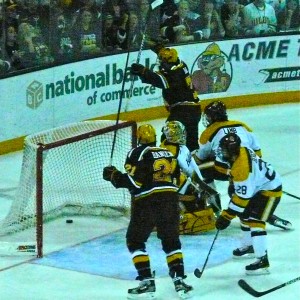
Freshman Kyle Rau squeezed the puck in for one of his three goals in Minnesota's 5-4 first-game victory over UMD.
The Gophers appear to be headed for a return to WCHA prominence, and if they do, it will be because of their younger players. In the first game, sophomore Erik Haula scored twice, as did freshman Kyle Rau, who was last seen diving to the ice to bunt in the overtime game-winning goal to break Duluth hockey hearts by lifting Eden Prairie to victory over Duluth East. Meanwhile Nate Condon, another sophomore, came up with the game-winner in overtime to snuff the Bulldogs in last Friday’s series opener.
“It means everything,†said Condon. “It’s our first conference match-up, and to come here and win especially, against Duluth, the top team.â€
At the same time, UMD’s young players also jumped into the spotlight. Trailing 2-0, freshman Caleb Herbert made a spectacular rush to cut inside defenseman Ben Marshall and put a neat backhand in past goaltender Kent Patterson an instant before leaping for glee at the crease. Senior Travis Oleksuk, old reliable, scored in both games. Late in a speedy third period, Justin Crandall, another UMD freshman, scored a huge goal to give UMD its first lead of the game, at 4-3 with 2:00 remaining. The Bulldogs had their break, and they rallied in front of goaltender Kenny Reiter, but the Gophers had a couple more breaks up their sleeve. During a scuffle in front, Haula got his stick on the puck and it glanced in off a defenseman’s skate to tie the game with 0:45 remaining in regulation. Then Condon came off the bench and raced to the net to whack Taylor Matson’s bounced pass out of the air to win the game with 56.7 seconds left in overtime.
UMD outshot Minnesota 50-44, but the Bulldog power play was a decent 1-5 while the Gopher power play connected on 3-6. The Bulldogs played well enough to win, and could well have won, but giving up the tying goal in the last minute of regulation and the winning goal in the last minute of regulation left the sting reality that last season is officially over.
The next night, UMD turned up the intensity, outshooting Minnesota 50-16, but found themselves out of breaks and apparently out of the game after seeing a 2-0 lead dissolve into a 5-2 deficit. Oleksuk and Jack Connolly, the two go-to senior guns up front, staked the Bulldogs to their early lead. But Minnesota senior Jake Hansen and Condon scored goals on the third and fourth Gopher shots of the first period, gaining a 2-2 deadlock, even though UMD outshot the Gophers 18-4.
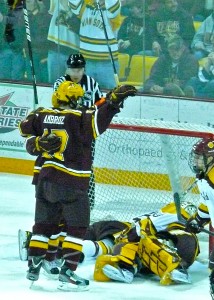
UMD defenseman Chris Casto dived into the net, after inavertently knocking in a Gopher goal credited to Nate Condon.
Condon said his teammates heckled him after the period for having “one goal and no shots,†because his shot off the end glass bounced crazily to the crease, and UMD freshman defenseman Chris Casto inadvertently knocked it past Reiter and into the goal. Casto dived in after it, but too late.
In the second period, big Scott Bjugstad swiped the puck and scored on a breakaway to make it three straight goals on three shots, Condon scored his third goal of the weekend to make it 4-2, at a point when UMD held a 27-7 edge in shots.
Midway through the third period, Rau scored his third goal of the weekend for a 5-2 Minnesota lead. It seemed like one of those games where UMD would get all the shots but the Gophers would get all the goals. But Herbert, the former Bloomington Jefferson star who had scored to get UMD untracked Friday, came up with a huge goal with 8:22 remaining to cut the UMD deficit to 5-3. And J.T. Brown cleanly intercepted a careless Gopher outlet pass and moved in to beat goaltender Kent Patterson with 5:05 left. Plenty of time for a closing rally, and the Dogs did rally, outshooting Minnesota 20-6 in the final period, but the Bulldogs were unable to get one more break, and were unable to score again, falling 5-4. UMD was 1-6 on power plays, and Minnesota 3-3. For the game, UMD outshot Minnesota 50-16, making it 100-60 for the weekend. And 0-2.
It’s going to take a little time to get everybody up to the same rhythm, but UMD’s effort was outstanding. This weekend, the Bulldogs are off to Providence and Minnesota goes home to play Vermont, in a pair of nonconference match-ups. Then it’s back to the WCHA chase, where Minnesota isn’t the only surprise. Michigan Tech, if you didn’t notice, swept Wisconsin 2-1 and 3-2 in a pair of overtime thrillers, indicating a wild race ahead. The Bulldogs have no need to panic, just the need to get their speedy attackers into a better rhythm of working together and scoring a little on the power play.
Meanwhile, UMD’s women open WCHA play at Amsoil against No. 1 Wisconsin, which split a rousing series against Minnesota in Madison last weekend. There hasn’t yet been a game in 12 years between Wisconsin and UMD that wasn’t of playoff championship quality, and this weekend’s series could be more of the same.
UMD’s football team caught a break last weekend when Wayne State was upset, opening up a clear shot at another Northern Sun title for the once-beaten Bulldogs. But not without some hard work and consistency, which they will display against Northern State in Saturday’s 1 p.m. homecoming game.
HIGH RISK OF SPORTS
In and around the Gopher-Bulldog hockey series, it was exciting to watch Texas finish off Detroit in the American League playoffs, while St. Louis was simply the better team in beating Milwaukee, when the Brewers picked an inopportune time to come completely unglued with a comedy of errors allowing the Cardinals to beat them and waltz into the World Series. Texas and St. Louis should put on a great World Series. We’ll see.
In the NFL, the Vikings had a horrendous night, again, this time against Chicago in a devastating 39-10 setback. At 1-5, rookie Christian Ponder will replace Donovan McNabb at quarterback, and since this seems to be the year of emerging young quarterbacks in the NFL, we shouldn’t have been surprised that Ponder looked so impressive in brief duty in the fourth quarter at Chicago. Nor should we be surprised if he breathes new life into the otherwise talented Vikings this weekend. The unbeaten and apparently invincible Green Bay Packers come to the Metrodome to face the Vikings, and nobody with a sound mind would pick the stumbling Vikings to beat Aaron Rodgers and the slick Packers. But I think the timing might be perfect for the Vikings to take a spirited run at them. Sure, the Packers could destroy the Vikings by six touchdowns, but watch out for Ponder to lead the Vikings to a belated come-together game and possibly the biggest upset of the season.
As for the Gophers, I do not anticipate anything resembling an upset against Nebraska on Saturday. I’m not sure Nebraska is a super-power, but the Gophers seem to self-destruct against mediocre teams, and even if they play their best game of the season I can’t foresee them giving the Huskers anything resembling a challenge.
BIGGEST RISK OF ALL
While watching all the games last weekend, the sobering realization clicked once again that hockey teams, football teams, and baseball teams all can win and lose, but there can be nothing that puts into proper perspective how those are just games than to see the ultimate risk faced by race drivers in the high-speed world of the IRL. You must have seen the season finale at Las Vegas on Sunday, or maybe you saw downtime during the two hours while track officials tried to clear up the debris from a 15-car mass mayhem crash going into Turn 2 on the high-banked oval.
Finally, the worst news came. Race driver Dan Wheldon had died of injuries in the crash.
Every time an athlete dies, with a disproportionate number of them being race drivers, everybody talks about what a great guy he was. In Wheldon’s case, it was true. The 33-year-old Englishman with the ready smile was an outstanding driver, and his situation tells a lot about where high-buck, open-wheel racing is right now. The IRL isn’t close to Formula 1 for exotic cars and exotic places to race, but Formula 1 displays its excellence on the greatest road-race courses of the world. The IRL runs on some road courses but also runs on some ovals, with the most significant being the Indianapolis 500.
But the Indianapolis Motor Speedway is a 2.5 mile oval with long straightaways and barely any banking in the four corners. The other ovals in the U.S., such as at Las Vegas, are higher banked in order to contain the popular big NASCAR stock cars. IRL cars can run at speeds up to about 225 miles per hour, and because this was the final race for the season, promoters were trying to lure as many drivers as possible.
They ended up with 34 drivers, one more than are spread out around Indy, and they would be piled together in a pack on only a 1.5-mile oval. They also would be going at incredible speeds because of the banking, which reduces the need, or the inclination, to lift off the throttle.
But here’s the harsh reality. Those promoting IRL races are desperate because crowds have fallen off in tough economic times. NASCAR writers claim that IRL fans turn to NASCAR, but I don’t believe that. There are still few similarities between the two. At any rate, as a final lure to attract media attention, promoters offered a bonus of $5 million to any IRL driver who didn’t have a regular full-season ride, if that driver would agree to start last in the field and try to win. A fan was selected who would split the prize, $2.5 million each.
Dan Wheldon won the 2005 Indianapolis 500, which is best remembered as the first Indy that Danica Patrick raced in. I was sitting near Turn 1 and watched as Patrick captured the fancy of 400,000 race fans by moving into the lead with only a few laps left, but her gamble on making it on her final drops of fuel fell short by just a couple of laps, and Wheldon sped past her to win the race.
Wheldon didn’t have the financial backing to get a full season contract this year, but he did put together a one-time deal for Indy, and won what had to be a spectacularly satisfying second 500 this past May, gaining the lead late when an inexperienced driver made a late mistake and yielded the lead.
Because he didn’t have a full-season ride, Wheldon jumped at the chance to put together a deal and try to go from last to first in the Las Vegas final. While many other drivers, and Wheldon, were outspoken in their criticism of the speeds of the cars on the smooth, high-banked, short oval track, and the inexperience of some entries. The cars were certain to bunch up, and as they reached 225 in a pack, any slight mistake would be compounded with the inability to react in such heavy traffic.
Several drivers, including Franchitti and Patrick, said they tried to race over the first few laps, then backed off and dropped to the lower part of the track, because it was too risky to try to run with the over-aggressive inexperienced drivers. But Dan Wheldon didn’t back off, because he had too much riding on his outcome. He started 34th, and wove his way up through the back-markers, passing 10 cars on the first 12 laps.
He had no way of knowing what was about to happen in the cluster of cars running just ahead. One driver seemed to get slightly out of shape, and his wing touched another car’s rear tire. When that happens, one of the cars might go out of control, but the other is likely to be vaulted upward. Several cars spun and slammed into the outer wall. Several had nowhere to go when spinning, swerving cars abruptly appeared directly in their path at over 200 mph.
Fireballs were everywhere as cars hit other cars and some hit the outer wall, with at least two of them flipping. Just about at that instant, Wheldon’s car sailed into the mess. With the entire track clogged with spinning, crashing cars, Wheldon’s No. 77 struck a spinning car and went airborne. It flipped and cartwheeled to the outside, and it appeared his car was too high to hit the padded outer wall and directly struck the catch fence above it — cockpit first.
All the other drivers were checked and all of them knew that Dan Wheldon was in the most precarious situation. All expressed the fervent hope he would be OK, as he was airlifted by helicopter to a Las Vegas hospital. Two hours later, the grim news came out. One of the most charming and engaging personalities on the circuit, and an excellent race driver, had lost his life. The drivers insisted the race be terminated, and the 19 remaining cars formed up in rows of three and drove five slow laps as a tribute to their fallen friend.
I thought it was one of the most moving things I’ve seen, and when “Amazing Grace†was played over the loudspeakers, it seemed appropriate — far more appropriate than an earlier rendition of “Danny Boy†that proved that, indeed, they were in Las Vegas, and show business was still out there.
Everyone has expressed all the grief that is felt throughout auto racing, and the usual complaints about speeds being too fast, and tracks accommodating too much speed. They are right, of course. So is the suggestion that IRL cars should race on road courses rather than short ovals.
But to me, the most unforgivable element of a tragic day in sports was the sickening, show-biz style promotion of coaxing someone to risk it all and try a virtually impossible charge from last to first for the whopping lure of $5 million. It was extra incentive that was completely unnecessary and inappropriate in a high-speed sport like Indy Car racing — which, lest anyone forget, is already at the outer limits of being too high-risk.




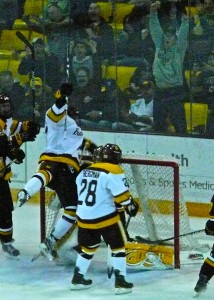
 John Gilbert is a lifetime Minnesotan and career journalist, specializing in cars and sports during and since spending 30 years at the Minneapolis Tribune, now the Star Tribune. More recently, he has continued translating the high-tech world of autos and sharing his passionate insights as a freelance writer/photographer/broadcaster. A member of the prestigious North American Car and Truck of the Year jury since 1993. John can be heard Monday-Friday from 9-11am on 610 KDAL(www.kdal610.com) on the "John Gilbert Show," and writes a column in the Duluth Reader.
John Gilbert is a lifetime Minnesotan and career journalist, specializing in cars and sports during and since spending 30 years at the Minneapolis Tribune, now the Star Tribune. More recently, he has continued translating the high-tech world of autos and sharing his passionate insights as a freelance writer/photographer/broadcaster. A member of the prestigious North American Car and Truck of the Year jury since 1993. John can be heard Monday-Friday from 9-11am on 610 KDAL(www.kdal610.com) on the "John Gilbert Show," and writes a column in the Duluth Reader.